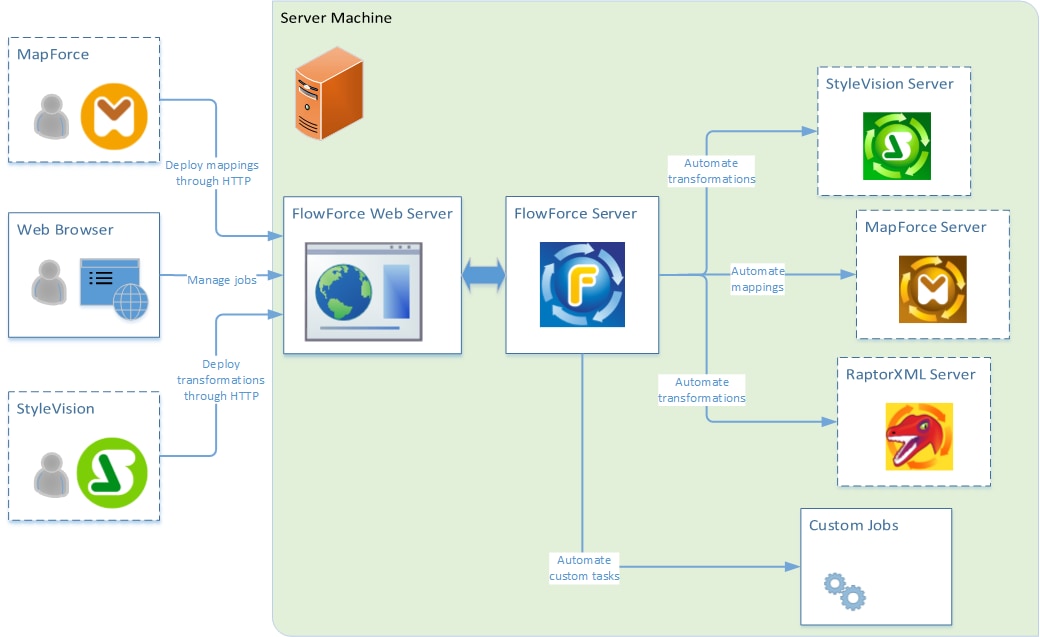Overview
Altova website: ![]() Workflow Automation Tool
Workflow Automation Tool
This topic describes the FlowForce Server architecture. The architecture is illustrated in the diagram below. The components that are optionally licensed are represented with dashed borders. The FlowForce Server solution consists of two services: FlowForce Web Server and FlowForce Server. They run as separate services and can be configured, started, and stopped separately. The manner in which these two services are managed depends on the operating system family (Linux and Windows).
FlowForce Web Server accepts and validates requests from clients (see Clients below) and passes these requests to FlowForce Server. FlowForce Server is the core of the FlowForce Server solution and runs as a background service without a graphical user interface. FlowForce Server continuously checks for trigger conditions, starts and monitors job execution, and logs all system- and job-related events. In addition to this, FlowForce Server listens to requests for jobs that are exposed as Web services.
FlowForce Web Server handles requests through the Web administration interface where you can create, modify, and monitor jobs, create users and roles, define privileges and permissions, and configure various FlowForce settings. FlowForce Web Server accepts HTTP (or HTTPS) connections from the clients described below. For information about terminology associated with job configuration and execution, see Terminology.
FlowForce Server can be integrated with other Altova products. For details, see Clients and Integration with Altova Server Products below.

Clients
The clients from which FlowForce Web Server can accept requests and send them further to FlowForce Server are described below.
Web browser
A Web browser is used to configure FlowForce Server jobs and various settings. For an overview of the Web administration interface, see Web UI Reference.
MapForce Enterprise and Professional editions
MapForce is a data mapping desktop application in which you visually design mappings that transform your data or convert it from one format to another. Once you have created your mapping in MapForce, you can deploy it to FlowForce Server. This will enable you to convert your mapping to a flexibly configurable job. For example, you can configure a mapping job that will run at a specific time or whenever a file is added to the monitored directory.
To run jobs created from MapForce mappings, FlowForce Server calls MapForce Server, whose role is to actually execute mappings and generate output files. For details about deploying MapForce mappings to FlowForce Server, see Integration with Altova Products.
StyleVision Enterprise and Professional editions
StyleVision is a desktop application that enables you to visually design reports and forms for XML, database, and XBRL data. StyleVision enables you to create StyleVision Power Stylesheets (i.e., SPS) that control the display and entry of data of databases, XML and XBRL documents and specify the output design of an XML document transformation. Once you have designed your SPS, you can save it as a Portable XML Form (PXF) file that packages the SPS file with its related files and deploy this PXF file to FlowForce Server. The deployed file then becomes available for use in any transformation job on the server.
To execute jobs created from deployed StyleVision transformations, FlowForce Server calls StyleVision Server, whose role is to actually execute transformations and produce output files.
For more information about each product, refer to the Altova documentation page (https://www.altova.com/documentation.html).
Integration with Altova server products
You can integrate FlowForce Server with other Altova server products. This enables you to automate these servers' tasks with the help of FlowForce Server. On Windows, the FlowForce Server installer comprises several Altova server products that you can install in addition to FlowForce Server. On other platforms, the Altova server products need to be installed separately. For information about each server product, see the subsections below.
StyleVision Server
StyleVision Server is based on the built-in report and document generation engine developed for StyleVision. StyleVision Server uses PXF files, which contain StyleVision stylesheets with related files, to render XML, XBRL, and database data into HTML, RTF, PDF, text, and Microsoft Word files. You can automate business report and document generation by deploying PXF files to FlowForce Server. This will enable you to run data transformations as scheduled jobs.
MapForce Server
MapForce Server is based on the built-in data transformation engine developed for MapForce. MapForce Server performs data transformations, using preprocessed data mappings stored in MapForce Server Execution (MFX) files. When MapForce Server operates under the management of FlowForce Server, data mappings are executed as FlowForce Server job steps.
RaptorXML Server
RaptorXML Server is Altova's third-generation, super-fast XML and XBRL processor, optimized for the latest standards and parallel computing environments. RaptorXML is available in two editions: RaptorXML Server and RaptorXML+XBRL Server. XBRL processing is available only in RaptorXML+XBRL Server.
When you integrate RaptorXML Server and FlowForce Server, RaptorXML Server's functions become available as built-in FlowForce Server functions. This means that you can create jobs that validate and check the well-formedness of XML and JSON documents, XBRL taxonomies and instance files. You can also perform XSLT transformations and execute XQuery documents. For more information, see Integration with RaptorXML Server.
For more information about each product, refer to the Altova documentation page (https://www.altova.com/documentation.html).